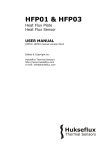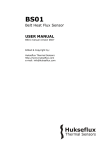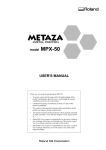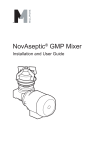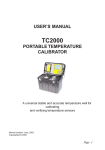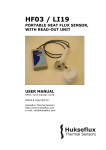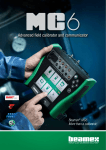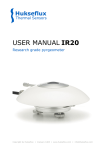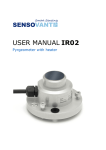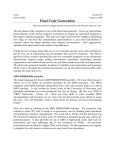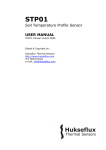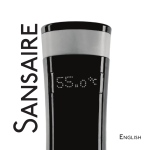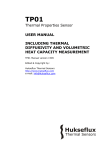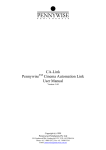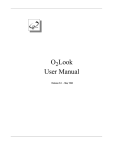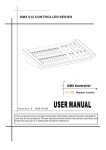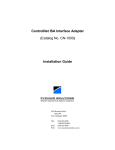Download HF01 manual v1211 - Hukseflux - Thermal Sensors
Transcript
HF01 High Temperature Heat Flux Sensor USER MANUAL/version 1211 Edited & Copyright by: Hukseflux Thermal Sensors http://www.hukseflux.com e-mail: [email protected] Hukseflux Thermal Sensors Warning: HF01 sensor and metal sheathed cable excluding the seal-pot are specified for use up to 800 degrees C. PTFE cable and seal-pot are specified for use up to 240 degrees C. Use above temperatures mentioned can lead to permanent damage to the sensor. Under no condition more than 30 VDC should be put across the HF01 output wiring. Putting any tension above 30V across HF01 wiring possibly will result in permanent damage. In case of mounting on objects that are under tension, for instance aluminium melting furnaces, care must be taken by the user to avoid any safety risk due to the electrical conduction of the metal sheathed cable. HF01 manual v1211 page 2/26 Hukseflux Thermal Sensors Contents 1 1.1 1.2 1.3 2 3 4 5 6 7 8 9 10 10.1 10.2 10.3 10.4 10.5 List of symbols 4 Introduction 5 Theory 7 General heat flux sensor theory 7 Detailed description of the measurement: resistance error, contact resistance, deflection error and temperature dependence 9 Sensor and surface temperature measurement 13 HF01 theory 14 Specifications of HF01 15 Short user guide 17 Putting HF01 into operation 18 Installation of HF01 19 Maintenance of HF01 19 Requirements for data acquisition / amplification 20 Electrical connection of HF01 21 Appendices 22 Appendix on cable extension for HF01 22 Appendix on trouble shooting 23 Appendix on heat flux sensor calibration 24 Delivery and spare parts 25 CE declaration of conformity 26 HF01 manual v1211 page 3/26 Hukseflux Thermal Sensors List of symbols Voltage output Sensitivity Time Response time Temperature Electrical resistance Thermal resistance Thickness Diameter Heat flux U E t T Re Rt H D V V/K s s K m2K/W m m W/m2 Subscripts Property of the thermopile sensor Property of the thermocouple HF01 manual v1211 sen TC page 4/26 Hukseflux Thermal Sensors Introduction The HF01 high temperature heat flux sensor is used to perform measurement of heat fluxes and surface temperature at high temperatures. The HF01 has been designed for studies of the energy balance of industrial furnaces, boilers, fluidised beds, distillation colums and ovens. It is originally designed as a tool in analysis of (aluminium) melting furnaces. The same technology can be used to manufacture heat flux sensors for different applications. The actual sensor is incorporated in a fully stainless steel housing. The first part of the cabling is metal sheathed, with an additional metal protection hose. The sensor as well as the metal cable can withstand temperatures up to 800 degrees C. The extension cable is made of PTFE. Sensor output consists of a heat flux signal (microvolt analogue signal) and a temperature signal (type K thermocouple). Suggested applications are for studies of energy balance of furnaces and studies of aluminium melting furnaces. The normal sensor is equipped with a metal sheathed cable that is extended (with in intermediate seal-pot) by a PTFE wire. As options one can obtain: 1. extended cable (PTFE or metal sheathed) 2. metal frame with magnets (MF01) for mounting on magnetic surfaces (works up to 550 degrees C) Alternative designs: Hukseflux is specialised in heat flux sensor design. For different applications special models can be constructed. HF01 complies with IP65 protection class. It complies with the CE directives. HF01 manual v1211 page 5/26 Hukseflux Thermal Sensors 4 1 7 2 6 40 H F01 S N xxxx 3 1 2 3 4 ø25 90 5 1 Figure 0.1 HF01. The heat flux sensor (1), connected to a metal sheathed cable with flexible hose (2) and PTFE extension cable (3).The frame (4) with magnets (5) is an option which is intended for temporary mounting on iron furnace walls. The silicone sleeve (6) protects the flexible hose. The flexible hose is protected by the silicone sleeve (6) and the strain relief (7). Dimensions are in mm. HF01 manual v1211 page 6/26 Hukseflux Thermal Sensors 1 Theory 1.1 General heat flux sensor theory As in most heat flux sensors, the actual sensor in HF01 is a thermopile. This thermopile measures the differential temperature across the body of HF01. Working completely passive, it generates a small output voltage that is proportional to this differential temperature. Assuming that the heat flux is steady, that the thermal conductivity of the body is constant and that the sensor has negligible influence on the thermal flow pattern, the signal of HF01 is proportional to the local heat flux in Watt per square meter. Using HF01 is easy. For readout one only needs an accurate voltmeter that works in the millivolt range, also capable of reading out type K thermocouples. To convert the measured voltage Vsen to a heat flux , the voltage must be divided by the sensitivity Esen, a constant that is supplied with each individual sensor. The following simple formula is valid as a first approximation. In case of HF01, a temperature dependence will be introduced to perform correct measurements at high temperatures. = Usen / Esen HF01 manual v1211 1.1.1 page 7/26 Hukseflux Thermal Sensors Figure 1.1 General characteristics of a heat flux sensor like HF01. When heat (6) is flowing through the sensor, the filling material (3) will act as a thermal resistance. Consequently the heat flow will go together with a temperature gradient across the sensor, creating a hot side (5) and a cold side (4). The majority of heat flux sensors is based on a thermopile; a number of thermocouples (1,2) connected in series. A single thermocouple will generate an output voltage that is proportional to the temperature difference between the joints (copper-constantan and constantan-copper). This temperature difference is, provided that errors are avoided, proportional to the heat flux, depending only on the thickness and the average thermal conductivity of the sensor. Using more thermocouples in series will enhance the output signal. In the picture the joints of a copper-constantan thermopile are alternatively placed on the hot- and the cold side of the sensor. The two different alloys are represented in different colours 1 and 2. The thermopile is embedded in a filling material, usually a plastic; in case of HF01 a ceramic material. Each individual sensor will have its own sensitivity, Esen, usually expressed in Volts output, Vsen, per Watt per square meter heat flux . As a first approximation, the flux is calculated = Usen/ Esen. The sensitivity is determined at the manufacturer, and is found on the calibration certificate that is supplied with each sensor. In case of HF01, the sensitivity usually is compensated for temperature. Also an independent temperature is incorporated in HF01. HF01 manual v1211 page 8/26 Hukseflux Thermal Sensors 1.2 Detailed description of the measurement: resistance error, contact resistance, deflection error and temperature dependence As a first approximation, the heat flux is expressed as: = Usen / Esen 1.2.1 This paragraph offers a more detailed description of the heat flux measurement. It should be noted that the following theory for correcting deflection and resistance errors is not often applied. Usually one will work with formula 1.2.4, only corrected for temperature. When mounting the sensor in or on an object with limited thermal resistance, the sensor thermal resistance itself might be significantly influencing the undisturbed heat flux. One part of the resulting error is called the resistance error, reflecting a change of the total thermal resistance of the object. A first order correction of the measurement is: = (Rthobj+Rthsen ) V sen /E sen Rthobj 1.2.2 Figure 1.2.1 The resistance error: a heat flux sensor (2) increases or decreases the total thermal resistance of the object on which it is mounted (1) or in which it is incorporated. This can lead either to a larger of smaller (increase of or decrease of the- ) heat flux (3). HF01 manual v1211 page 9/26 Hukseflux Thermal Sensors Figure 1.2.1 The resistance error: a heat flux sensor (2) increases or decreases the total thermal resistance of the object on which it is mounted or in which it is incorporated. An otherwise uniform flux (1) is locally disturbed (3). In this case the measured heat flux is smaller than the actual undisturbed flux,( 1). In addition to the resistance error, the fact that the thermal conductivity of the surrounding medium differs from the sensor thermal conductivity causes the heat flux to deflect. The resulting error is called the deflection error. The deflection error is determined in media of different thermal conductivity by experiments or using theoretical approximations. The result of these experiments is laid down as the so-called thermal conductivity dependence E. The order of magnitude of E is constant for one sensor type. For HF01 this correction is normally not used. Esen = E sen, cal (1+E (cal - med)) HF01 manual v1211 1.2.3 page 10/26 Hukseflux Thermal Sensors Figure 1.2.2 The deflection error. The heat flux (1) is deflected in particular at the edges of the sensor. As a result the measurement will contain an error; the so-called deflection error. The magnitude of this error depends on the medium thermal conductivity, sensor thermal properties as well as sensor design. In addition, the sensitivity of heat flux sensors is temperature dependent. The temperatre dependence TD reflects the fact that the sensitivity changes with temperature: Esen = E sen, cal (1+TD (Tsen – Tref )) HF01 manual v1211 1.2.4 page 11/26 Hukseflux Thermal Sensors Apart from the sensor's own thermal resistance, and temperature dependence, also contact resistances between sensor and surrounding material are demanding special attention. Essentially any air gaps add to the sensor thermal resistance, at the same time increasing the deflection error in an unpredictable way. In all cases the contact between sensor and surrounding material should be as well and as stable as possible, so that it is not influencing the measurement. It should be noted that the conductivity of air is approximately 0.02 W/m.K, ten times smaller than that of the heat flux sensor. It follows that air gaps form major contact resistances, and that avoiding the occurrence of significant air gaps should be a priority whenever heat flux sensors are installed. In particlar in high flux applications on uneven surfaces, such as covers of aluminium ovens, the contact resistance has proven to be a very important factor. It is recommended to clean surfaces before monting the sensor, and also if possible to use thermal paste in order to improve the contact between sensor and surface. HF01 manual v1211 page 12/26 Hukseflux Thermal Sensors 1.3 Sensor and surface temperature measurement The measurement of the sensor temperature is performed by a thermocouple type K. The measured temperature is intended as a temperature measurement of the sensor itself in order to carry out temperature corrections according to formula 1.2.4 and 2.2. The temperature measured is also an indication of the temperature of the underlying surface, but the measurement accuracy is much harder to establish. The measurement error depends on the contact resistance as well as the heat flux. Assuming a situation of a hot surface on which the sensor is mounted, the measured temperature will be lower than the actual surface temperature. A worst case situation in aluminium melting furnaces: with a typical iron surface at a temperature of 370 degrees C and a flux of 15 kW/m2, the measurement shows 340 degrees, and error of -30 degrees C. HF01 manual v1211 page 13/26 Hukseflux Thermal Sensors 2 HF01 theory A heat flux sensor like HF01 consists of the sensor material (in this case type K thermocouples), filler material (a ceramic) and housing material (stainless steel for HF01). Ignoring the deflection and resistance errors (mentioned previously) the sensor output Usen is treated in the following way: = Usen /((1+TD.(T- Tref)). Esen ) 2.1 or with TD = -0.0008 and Tref = 90 degrees C = Usen /((1-0.0008.(T- 90)). Esen ) 2.2 With Esen , the sensor sensitivity, Usen the sensor output in V, TD the temperature dependence in %/K, Tref a reference temperature at which the initial calibration has been performed and the heat flux in W/m2. Esen, Tref, as well as TD are given in the HF01 calibration certificate. The formula 2.1 is still offering a crude approximation of reality; there are other non-linear effects that could be taken into account. At present it is the author’s opinion that the state of the art of heat flux calibration is such that further improvements are not resulting in improvement of accuracy. Apart from heat flux, also a surface temperature measurement is performed using HF01. This is a normal type K thermocouple measurement. HF01 manual v1211 page 14/26 Hukseflux Thermal Sensors 3 Specifications of HF01 The HF01 high temperature heat flux sensor is used to perform measurement of heat fluxes and surface temperature at high temperatures. It is designed in particular for industrial research applications. The same technology can be used to manufacture heat flux sensors for different applications. HF01 must be used with proper read-out equipment. GENERAL SPECIFICATIONS OF HF01 Specified Heat Flux in W/m2 and surface measurements temperatures within specified working ranges Working range 0.05 to 50 kWm-2 Temperature range -30 to +800 °C. sensor and metal sheathed cable Temperature range -30 to +240 °C PTFE cable PTFE cable length 3500 mm (see options) Metal cable length 900 mm (see options) ISO requirements No ISO standards are applicable Protection sensor / IP 65 cable Optional items Metal Frame with magnets (MF01) (to 550 °C only), cable extension CE requirements HF01 complies with CE directives Power requirements No power required Weight Sensor and cable 300 grams Including storage box, 820 grams Connection Signal: RED positive BLACK negative GREEN: thermocouple + WHITE: thermocouple Heat flux from the black surface typically facing out, to the blank surface, typically mounted on the object of interest, is positive. Polarities can be reversed without any significant effect. Table 2.1 List of HF01 specifications (continued on the next page) HF01 manual v1211 page 15/26 Hukseflux Thermal Sensors Shielding NOTE: PTFE cabling shield is normally NOT connected to metal cable outer jacket. Transport details weight & dimensions please inquire at manufacturer MEASUREMENT SPECIFICATIONS Thermocouple Type K, traceable to ANSI MC96.1-1982 Expected accuracy / Heat flux measurement: accuracy: +/repeatability 15% depending on exact conditions (see chapter 2) / repeatability +/- 5% Temperature Measurement: accuracy depending on exact conditions (see chapter 2) +2/-5 degrees C/ repeatability: +/- 1 degree C, both at zero heat flux. SENSOR SPECIFICATIONS Thermocouple Type K, traceable to ANSI MC96.1-1982 Esen 0.5 10-3 mV/W.m-2 @ 90 deg C (nominal) Temperature -8.10-2 %/K dependence Required readout 1 diff voltage, 1 thermocouple type K channel Required mounting HF01 should be mounted on a reasonably smooth surface. In order to meet the specified accuracies, contact resistance should be minimised. It is possible to use thermal paste to promote contact. Thermopile 10 to 30 Ohm resistance Thermocouple 10 to 50 Ohm resistance Sensor dimensions 25 mm diameter, 6 mm thickness Average thermal 1.4 W/mK (nominal value) conductivity Total thermal 0.0042 m2K/W resistance Response time ± 5 min (depends on quality of thermal (nominal) contact) Coating The sensor outer surface is coated black. Emissivity: 0.92. CALIBRATION Calibration to electrical power and surface area traceability Table 2.1 List of HF01 specifications (second part) HF01 manual v1211 page 16/26 Hukseflux Thermal Sensors 4 Short user guide Preferably one should read the introduction and first chapters to get familiarised with the heat flux measurement and the related error sources. The sensor should be installed following the directions of the next paragraphs. Essentially this requires a data logger and control system capable of readout of voltages and thermocouples as well as capable to perform division of the measurement by the sensitivity and making a temperature correction. The first step that is described in paragraph 5 is and indoor test. The purpose of this test is to see if the sensor works. The second step is to make a final system set-up. This is strongly application dependent, but it usually involves permanent installation of the sensor and connection to the measurement system. Directions for this can be found in paragraphs 6 to 11. HF01 manual v1211 page 17/26 Hukseflux Thermal Sensors 5 Putting HF01 into operation It is recommended to test the sensor functionality by checking the impedance of the sensor, the thermocouple, and by checking if the sensor works, according to the following table: (estimated time needed: 15 minutes) Warning: during this part of the test, please put the sensor in a thermally quiet surrounding because a sensor that generates a significant signal will disturb the measurement. The typical impedance of the wiring is 0.1 ohm/m. Typical impedance should be 1.5 ohm for the total resistance of two wires (back and Check the impedance of the sensor forth) of each 5 meters, and thermocouple. Use a multimeter plus the typical sensor at the 100 ohms range. Measure at the impedance of 10-30 sensor output first with one polarity, ohms and thermocouple than reverse polarity. Take the impedance of 10-50 average value. Ohms. Infinite indicates a broken circuit; zero indicates a short circuit. Check if the sensor reacts to heat flux. The thermopile should Use a multimeter at the millivolt react by generating a range. Measure at the sensor output. millivolt output signal. Generate a signal by putting the The thermocouple sensor on a hot object, like a ceramic should show a realistic cooking plate at 500 degrees C. temperature. Table 5.1 Checking the functionality of the sensor. The procedure offers a simple test to get a better feeling how HF01 works, and a check if the sensor is OK. The programming of data loggers is the responsibility of the user. Please contact the supplier to see if directions for use with your system are available. HF01 manual v1211 page 18/26 Hukseflux Thermal Sensors 6 Installation of HF01 HF01 is generally installed at the location where one wants to measure. The more even the surface on which HF01 is placed the better. Care should be taken to prevent the creation of air gaps between sensor and surface. The use of thermal pasted should be considered to promote contact. Make sure that the thermal paste is not polluted by sand or other particles. Metal surfaces are typically cleaned using a metal bush. Care should be taken that cables and connections are not used beyond specified temperatures. Table 7.1 General recommendations for installation of HF01. In case of exceptional applications, please contact Hukseflux. 7 Maintenance of HF01 HF01 is essentially maintenance free. Usually errors in functionality will appear as unreasonably large or small measured values. As a general rule, this means that a critical review of the measured data is the best form of maintenance. At regular intervals the quality of the cables can be checked. On a 2 yearly interval the calibration can be checked in an indoor facility. HF01 manual v1211 page 19/26 Hukseflux Thermal Sensors 8 Requirements for data acquisition / amplification General Capability to measure microvolt signals Capability to read out thermocouple type K signals Capability for the data logger or the software Electrical environments in industry, in particular around aluminium ovens, can be quite extreme. The suggestion is te test electronics performance in a realistic environment. In alminium ovens the situation can be worse than expected because typically long and unshielded extension cables are used. (shielding is not possible because of safety) Preferably: 5 microvolt accuracy Minimum requirement: 50 microvolt accuracy (both across the entire expected temperature range of the acquisition / amplification equipment) Preferably: 2 degrees accuracy Minimum requirement: 4 degrees accuracy To store data, and to perform division by the sensitivity to calculate the heat flux. Table 8.1 Requirements for data acquisition and amplification equipment. HF01 manual v1211 page 20/26 Hukseflux Thermal Sensors 9 Electrical connection of HF01 The total number of measurements that needs to be made is: Usen: voltage T sen: type K thermocouple The requirements for the MCU are summarised in the following table. In order to operate, HF01 should be connected to a measurement and system as described above. A typical connection is shown in table 9.1. HF01 is a passive sensor that does not need any power. Cables generally act as a source of distortion, by picking up capacitive noise. It is a general recommendation to keep the distance between data logger or amplifier and sensor as short as possible. For cable extension, see the appendix on this subject. Wire Colour Measurement system Sensor output + Sensor output - Red Black Thermocouple + Thermocouple - Green White Voltage input + Voltage input - or ground TC input + TC input - Table 9.1 The electrical connection of HF01. HF01 manual v1211 page 21/26 Hukseflux Thermal Sensors 10 Appendices 10.1 Appendix on cable extension for HF01 HF01 is equipped with one cable. It is a general recommendation to keep the distance between data logger or amplifier and sensor as short as possible. Cables generally act as a source of distortion, by picking up capacitive noise. HF01 cable can however be extended without any problem to 100 meters. If done properly, the sensor signal, although small, will not significantly degrade because the sensor impedance is very low. Extension is preferably done at Hukseflux, using the special HF01 cable. HF01 manual v1211 page 22/26 Hukseflux Thermal Sensors 10.2 Appendix on trouble shooting This paragraph contains information that can be used to make a diagnosis whenever the sensor does not function. The sensor does not give any signal The thermo couple does not give right signals The sensor signal is un realistically high or low. The sensor signal shows unexpected variations Measure the impedance across the sensor wires. This should be around 10-30 ohms plus cable resistance (typically 0.1 ohm/m). If it is closer to zero there is a short circuit (check the wiring). If it is infinite, there is a broken contact (check the wiring). This check can be done even when the sensor is installed (please ensure in this case to perform the measurement with two polarities and taking the average value). Check if the sensor reacts to an enforced heat flux. In order enforce a flux, it is suggested to mount the sensor on a hot object; preferably above 100 degrees C. Check the data acquisition by applying a mV source to it in the 1 mV range. Measure the impedance across the thermocouple wires. This should be around 10-50 ohms. If it is closer to zero there is a short circuit (check the wiring). If it is infinite, there is a broken contact (check the wiring). This check can be done even when the sensor is installed (please ensure in this case to perform the measurement with two polarities and taking the average value). Check if the right calibration factor is entered into the algorithm. Please note that each sensor has its own individual calibration factor. Check the readout of the thermocouple. Check if the voltage reading is divided by the calibration factor by review of the algorithm. Check if the mounting of the sensor still is in good order. Check the condition of the leads at the logger. Check the cabling condition looking for cable breaks. Check the range of the data logger; heat flux can be negative (this could be out of range) or the amplitude could be out of range. Check the data acquisition by applying a mV source to it in the 1 mV range. Check the algorithm for wrong temperature corrections. Check the presence of strong sources of electromagnetic radiation (radar, radio etc.) Check the condition of the shielding. Check the condition of the sensor cable. Table 10.2.1 Trouble shooting for HF01. HF01 manual v1211 page 23/26 Hukseflux Thermal Sensors 10.3 Appendix on heat flux sensor calibration Calibration of high temperature heat flux sensors like HF01 is not governed by any internationally accepted standards, The calibration is traceable to electrical power and surface area. The calibration reference conditions for HF01 calibration at Hukseflux are: Temperature: 75 °C Heat Flux: 1500 W/m2 A reliable and traceable calibration has been found for performing a well traceable “reference point” calibration of heat flux sensors at around 75 degrees and a flux level of about 1.5 kW/m2. The estimated accuracy is +/- 10%. Also it has proven to be possible to determine the temperature dependence of heat flux sensors in the 20 to 370 degrees Celsius range through a series of measurements at constant power. The combination of these two measurements can be considered an adequate calibration of the entire sensor for use within the 20 to 370 degrees C temperature range. Using linear approximated temperature dependence, the expected overall accuracy is roughly +/- 15%. It can be expected that the relative accuracy of the measurement, not suffering from the large inaccuracy of the “reference point”, is much better than the absolute accuracy. On the other hand application related errors (like distortion of local convection, added heat resistance, and differing optical properties), as well as possible non-linearity must be added. Temperature dependence is about -0.08%/K. HF01 manual v1211 page 24/26 Hukseflux Thermal Sensors 10.4 Delivery and spare parts HF01 delivery includes the following items: HF01 Sensor Calibration certificate HF01 manual v1211 page 25/26 Hukseflux Thermal Sensors 10.5 CE declaration of conformity According to EC guidelines 89/336/EEC, 73/23/EEC and 93/68/EEC We: Hukseflux Thermal Sensors Declare that the product: HF01 Is in conformity with the following standards: Emissions: Radiated: Conducted: EN 55022: 1987 EN 55022: 1987 Class A Class B Immunity: ESD RF EFT IEC 801-2; 1984 IEC 808-3; 1984 IEC 801-4; 1988 8kV air discharge 3 V/m, 27-500 MHz 1 kV mains, 500V other Delft August 2003 HF01 manual v1211 page 26/26


























